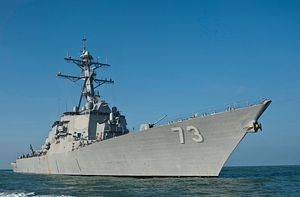Over at the Asia Maritime Transparency Initiative, Bonnie Glaser, Zack Cooper, and Peter Dutton outline a strong case for the next U.S. administration to stage its first freedom of navigation operation (FONOP) in the South China Sea near Mischief Reef. Given the large strategic questions surrounding the Trump administration’s overall foreign policy, there’s been little consideration of the tactical choices his administration could choose to make in the Asia-Pacific. FONOPs, perhaps more than any other action, will be a closely watched tactical move by the Trump administration.
A year ago, I incorrectly predicted that the Obama administration would venture to Mischief Reef after the first FONOP near Subi Reef and other features in the Spratly Islands way back in October 2015. The case for Mischief Reef is particularly interesting, given the feature’s geography in relation to nearby features in the Spratlys. Mischief Reef is notably the only feature containing a Chinese artificial island that is not within 12 nautical miles of any other feature. Moreover, one of the findings of the five-judge tribunal at the Permanent Court of Arbitration back in July was that Mischief Reef lies within the continental shelf of the Philippines.
As Glaser, Cooper, and Dutton outline, a FONOP near Mischief Reef is rendered likely considering the details of the fourth and most recent FONOP by the USS Decatur in October 2016. The Decatur tested China’s illegal straight baselines in the Paracel Islands and, notably, did not comply with the requirements for innocent passage under international law. Instead, the Decatur‘s freedom of navigation operation asserted high seas freedom. (The reasons why this is the case are outlined in greater detail by the AMTI authors.)
Indeed, if there was ever a FONOP to lay the groundwork for a high seas assertion in the 12 nautical mile zone around Mischief Reef — which is entitled to no special rights given the feature’s status as a low-tide elevation — the Decatur‘s operation did just that. As I noted a year ago, the Obama administration, given its hesitance in pushing China on the South China Sea issue at the expense of other issues in the bilateral relationship, “likely saw an operation near Mischief as too provocative for an initial freedom of navigation operation.” And there are real risks. For example, China could use the operation as a pretense to forward-deploy military assets to its artificial islands, including fighters that could potentially be used to enforce an air defense identification zone down the line.
With the incoming administration, there’s little telling where the U.S. Navy’s freedom of navigation program is likely to go. Neither Trump nor any of his declared staff with an interest in foreign affairs — such as national security advisor designate Michael Flynn — have discussed the issue of freedom of navigation directly. An op-ed in Foreign Policy outlining Trump’s Asia-Pacific foreign policy, by contrast, suggests a muscular role for the U.S. Navy in upholding the regional order, asserting that the “U.S. Navy is perhaps the greatest source of regional stability in Asia.”
The FONOP program in the South China Sea is likely to continue, especially given strong interest in intensifying operations and patrols more broadly from U.S. Pacific Command. There’s little telling how the incoming administration will decide to proceed with the FONOP options available. Instead of advancing to a high seas assertion around Mischief Reef, we could see another FONOP where a destroyer exercises innocent passage within 12 nautical miles of a China-claimed feature. As I noted in the 25th issue of the Diplomat‘s magazine this month, Trump’s shown little interest in sustaining the rules and norms and that underpin the Asia-Pacific’s maritime commons. In this sense, the location and type of the next FONOP — and the extent to which it is publicized — will be a useful barometer of where the next administration plans to expend its diplomatic capital in the Asia-Pacific.

































